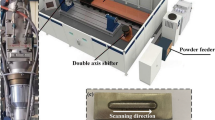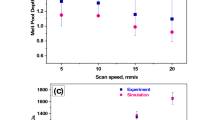Abstract
To analyze the influence of processing conditions on the melt pool geometry and dilution ratio of the Ni-based alloy during laser cladding, a finite element model of heat transfer and fluid flow with multi-physical parameters was established. This model is used to simulate the temperature and velocity fields of melt pool. Thermodynamic processes such as phase transition, Marangoni convection and buoyancy were considered in this model. Adding materials in real time was considered by introducing powder feeding rate. The relative energy–mass ratio (REMR) was introduced to simplify process analysis, and the effects of different processing parameters on the dilution rate and on the melt pool geometry were explored through the established model. The results show that dilution ratio and REMR are linearly related within a certain range. In addition, due to the fluid flow, the boundary at bottom of melt pool changes gradually from shallow arc shape to wave shape, and finally to deep arc shape with increased REMR.










Similar content being viewed by others
References
T. Debroy, H.L. Wei, J.S. Zuback et al., Additive manufacturing of metallic components—process, structure and properties. Prog. Mater Sci. 92, 112–224 (2017)
D.D. Gu, W. Meiners, K. Wissenbach et al., Laser additive manufacturing of metallic components: materials, processes and mechanisms. Int. Mater. Rev. 57(3), 133–164 (2013)
X. Lei, H. Cao, H. Liu et al., Study on laser cladding remanufacturing process with FeCrNiCu alloy powder for thin-wall impeller blade. Int. J. Adv. Manuf. Technol. 90(5–8), 1383–1392 (2017)
J.D. Kim, Y. Peng, Melt pool shape and dilution of laser cladding with wire feeding. J. Mater. Process. Technol. 104(3), 284–293 (2000)
H.E. Cheikh, B. Courant, S. Branchu et al., Analysis and prediction of single laser tracks geometrical characteristics in coaxial laser cladding process. Opt. Lasers Eng. 50(3), 413–422 (2012)
Z. Kai, M.Z. Xin, J.L. Wei, Influences of processing parameters on dilution ratio of laser cladding layer during laser metal deposition shaping. Adv. Mater. Res. 549, 785–789 (2012)
V. Manvatkar, A. De, T. DebRoy, Spatial variation of melt pool geometry, peak temperature and solidification parameters during laser assisted additive manufacturing process. Mater. Sci. Technol. 31(8), 924–930 (2015)
T. Mukherjee, J.S. Zuback, A. De et al., Printability of alloys for additive manufacturing. Sci. Rep. 6, 1–6 (2016)
M.M. Alam, A.F.H. Kaplan, J. Tuominen et al., Analysis of the stress raising action of flaws in laser clad deposits. Mater. Des. 46(4), 328–337 (2013)
N.A. Kistler, A.R. Nassar, E.W. Reutzel et al., Effect of directed energy deposition processing parameters on laser deposited Inconel (R) 718: microstructure, fusion zone morphology, and hardness. J. Laser Appl. 29(2), 12 (2017)
D.M. Goodarzi, J. Pekkarinen, A. Salminen, Effect of process parameters in laser cladding on substrate melted areas and the substrate melted shape. J. Laser Appl. 27(S2), S29201 (2015)
A.J. Pinkerton, Advances in the modeling of laser direct metal deposition. J. Laser Appl. 27(S1), S15001 (2014)
Y. Wei, B. Pathiraj, S. Liu, 2D modelling of clad geometry and resulting thermal cycles during laser cladding. J. Mater. Process. Technol. 230, 217–232 (2016)
E.A. Hochmann, I. Salehinia, How convection on the substrate affects the thermal history of the build in direct laser deposition—finite element analysis. Int. J. Adv. Manuf. Technol. 96(9), 1–10 (2018)
P. Peyre, M. Dal, S. Pouzet et al., Simplified numerical model for the laser metal deposition additive manufacturing process. J. Laser Appl. 29(2), 022304 (2017)
T. Mukherjee, V. Manvatkar, A. De et al., Mitigation of thermal distortion during additive manufacturing. Scr. Mater. 127, 79–83 (2017)
A. Raghavan, H.L. Wei, T.A. Palmer et al., Heat transfer and fluid flow in additive manufacturing. J. Laser Appl. 25(5), 1207–1216 (2013)
F. Vásquez, J.A. Ramos-Grez, M. Walczak, Multiphysics simulation of laser—material interaction during laser powder deposition. Int. J. Adv. Manuf. Technol. 59(9–12), 1037–1045 (2012)
T. Yu, J. Sun, H. Wang et al., Parameter selection of laser cladding TC11 titanium alloy simulated by temperature field. Laser Infrared 47(3), 284–290 (2017)
P. Yuan, D. Gu, Molten pool behaviour and its physical mechanism during selective laser melting of TiC/AlSi10Mg nanocomposites: simulation and experiments. J. Phys. D Appl. Phys. 48(3), 035303 (2015)
S. Morville, M. Carin, P. Peyre et al., 2D longitudinal modeling of heat transfer and fluid flow during multilayered direct laser metal deposition process. J. Laser Appl. 24(3), 032008-1–032008-9 (2013)
A. Bahrami, D.T. Valentine, B.T. Helenbrook et al., Study of mass transport in autogenous GTA welding of dissimilar metals. Int. J. Heat Mass Transf. 85, 41–53 (2015)
A.D. Brent, V.R. Voller, K.J. Reid, Enthalpy-porosity technique for modeling convection-diffusion phase change: application to the melting of a pure metal. Numer. Heat Transf. 13(3), 297–318 (1988)
V.R. Voller, C. Prakash, A fixed grid numerical modelling methodology for convection-diffusion mushy region phase-change problems. Int. J. Heat Mass Transf. 30(8), 1709–1719 (1987)
X. He, Capillary convection in pulsed—butt welding of miscible dissimilar couple. Proc. Inst. Mech. Eng. Part C J. Mech. Eng. Sci. 231(13), 2429–2440 (2016)
A. Kumar, S. Roy, Effect of three-dimensional melt pool convection on process characteristics during laser cladding. Comput. Mater. Sci. 46(2), 495–506 (2009)
J. Yang, F. Wang, 3D finite element temperature field modelling for direct laser fabrication. Int. J. Adv. Manuf. Technol. 43(11–12), 1060–1068 (2009)
S. You, K.J. Bathe, Structures, Transient solution of 3D free surface flows using large time steps. Comput. Struct. 158, 346–354 (2015)
J. Xie, Control research on dilution rate and process optimization in induction melting for preparation of Ni60 coating (China University of Petroleum, Qingdao, 2015)
D. Dai, D. Gu, Tailoring surface quality through mass and momentum transfer modeling using a volume of fluid method in selective laser melting of TiC/AlSi10Mg powder. Int. J. Mach. Tools Manuf. 88, 95–107 (2014)
G.F. Lian, M.P. Yao, Y. Zhang et al., Analysis and prediction on geometric characteristics of multi-track overlapping laser cladding. Int. J. Adv. Manuf. Technol. 97(5–8), 2397–2407 (2018)
Acknowledgements
The authors acknowledge the financial support from the independent innovation project of Anhui Province of China (No. 13Z02009), the key project of intelligent manufacturing institute of Hefei university of technology of China (No. IMICZ2015003).
Author information
Authors and Affiliations
Corresponding author
Additional information
Publisher's Note
Springer Nature remains neutral with regard to jurisdictional claims in published maps and institutional affiliations.
Rights and permissions
About this article
Cite this article
Tian, H., Chen, X., Yan, Z. et al. Finite-element simulation of melt pool geometry and dilution ratio during laser cladding. Appl. Phys. A 125, 485 (2019). https://doi.org/10.1007/s00339-019-2772-9
Received:
Accepted:
Published:
DOI: https://doi.org/10.1007/s00339-019-2772-9




